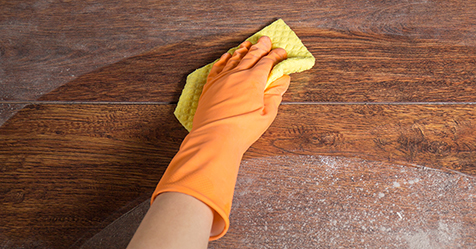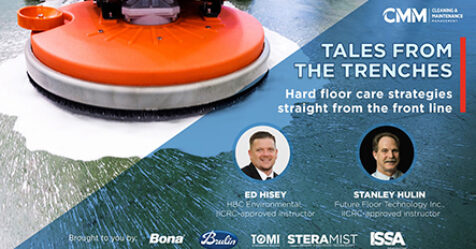Traditionally, floors have been cleaned using a cotton string mop and a bucket with diluted cleaning solution.
The mop was dunked into the solution, worked over an area and placed back into the same solution before being rung out and the process repeated.
While this procedure worked well for many years, it left much room for improvement.
For one, the clean solution did not stay fresh for very long.
After repeated passes with the mop, the once-clean solution became contaminated with soils, germs and bacteria from the floor.
This is problematic because it not only contaminates large swaths of the floor with pathogens that may have only been present in one specific area, but it also leaves a dirty film on the floor.
As a result, the old mop-and-bucket method requires repeated passes and numerous rinses to achieve clean floors.
However, because traditional mopping promotes cross-contamination, the cleanliness attained is merely visual and will not stand up to scientific cleanliness measurements.
Moreover, the constant motion of pushing and pulling a string mop and bending over to wring it out is an ergonomic nightmare.
Added to this terror are the facts that cotton string mops harbor potentially harmful germs and bacteria and develop musty malodors after recurring uses.
Luckily, recent advances in squeegee technology are coming to the rescue of frontline custodians in the JanSan industry.
Practicality And Productivity
“Some newer squeegees are made from a closed-cell foam rubber material that inhibits microbial growth and incorporates a flush and rinse design so they can be cleaned and allowed to dry, effectively stopping bacteria growth,” says Bruno Niklaus, vice president of global marketing Unger Enterprises Inc.
In addition, some squeegees are dishwasher-safe and launderable, which enables complete sanitization of the device after use.
Another benefit for infection control conscious end-users is that most squeegees are available with identifying markers in multiple colors, making a color-coded squeegee program a simple reality.
Aside from the ability to remove soils instead of spreading them, today”s squeegees offer ergonomic benefits as well.
By being adaptable to multiple handles of all lengths and material types, some squeegees can be used by multiple individuals without fear of injury with a simple swap of the handle.
If one person prefers the feel of a thicker, wooden handle and another enjoys the lightweight characteristics of a thinner, aluminum handle, both parties” preferences can be catered to in a snap.
“Universal socket designs allow the use of any handle already in a facility versus proprietary connections, making usage more efficient for all cleaning personnel,” notes Niklaus.
Because squeegees are efficacious on multiple surface types — including uneven surfaces like restroom floor tiles and even snow and ice removal — gains in productivity can be noticed in numerous applications.
And, with the availability of scrubbing heads on the reverse side of some squeegees, less time, effort and chemicals are needed to achieve comparable soil removal when contrasted to conventional mops.
A problem often noticed when cleaning restroom floors with conventional mopping techniques is the splashing of dirty mop water on walls and other items.
This, however, is not a problem with squeegees; in fact, squeegees are quite useful in cleaning restroom stall dividers and tiled walls.
Today”s custodial professionals demand options when it comes to cleaning floors in restrooms and other areas of a facility.
Squeegees are able to provide unmatched performance and could be the floor cleaning solutions you have been seeking.
With the many types of squeegees available to meet various challenges, it just might be time to speak with a representative or your local distributor to explore the many benefits a squeegee program can bring to your floor cleaning efforts.


